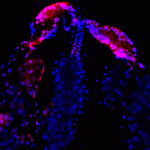Link to Pubmed [PMID] – 32035764
Link to DOI – S1471-4906(20)30002-810.1016/j.it.2020.01.002
Trends Immunol 2020 03; 41(3): 190-199
For decades, insect immunology has contributed groundbreaking discoveries on the intricacies of innate immunity. These discoveries have profoundly impacted our understanding of innate immunology in mammalian systems and improved human therapeutic interventions, from the composition of vaccines to cell-based immune therapies. Current knowledge of insect immunity mainly encompasses detailed molecular mechanisms and systemic responses to pathogen infection. However, the organs and specific cell populations involved in immune responses remain elusive. Here, we highlight the need for a better understanding of insect immune responses at the level of organs and cell populations. Not only will it improve our current understanding of tissue- or cell-specific immune processes across species, but it will also pave the way for spatial modeling of within-host infection dynamics.


